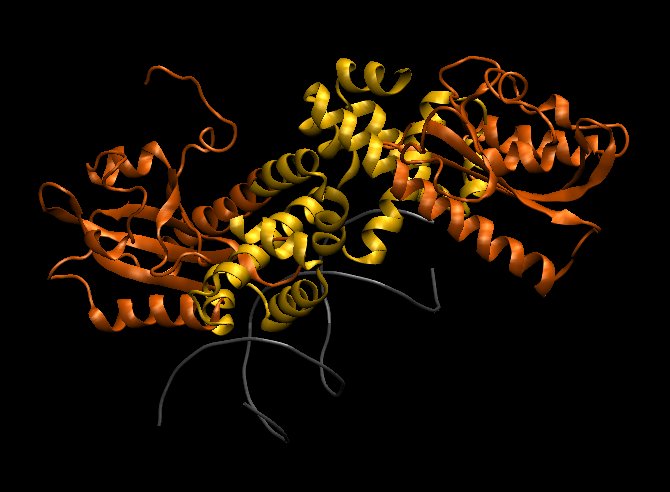Team:EPF-Lausanne/Results/Fusion
From 2009.igem.org




DNA-binding domain
Motivation and creation of LovTAP
The first step in our computational study of the LOV domain was to fuse the 2 domains of interest in VMD (Visual Molecular Dynamics). We were then able to visualize the different proteins tried by Sosnick.
The working protein, that we call LovTAP is the result of the fusion at PHE22 of trpR and can be seen on the next video.
The general LOV domain is in yellow. Please note the chromophore called Flavin (FMN) in red in the center of LOV2. The trpR dna binding domain is in orange and DNA in gray.
This particular protein gave the best results in vitro. The helix linking the 2 domains is nicely conserved and suggest that the conformational change in the FMN is transmitted through this rigid lever leading to a change of affinity of the trpR to DNA. You can go to our LOVTap section to have more details on this process. We will try to understand the movement of this helix by using a molecular dynamics software.
The fusion was made in VMD by aligning the alpha helix of both domains on the backbone of 3 residues. The secondary structure is quite strong, which makes this fusion realistic.
Click here to see an example of code used in VMD for the fusion
We also modelized the other fusion tried by Sosnick, even if they did not really worked in his article, and our modelizations confirmed that the alignment was not good enough to allow further reaction.
- @MET11
- @ALA12
- @GLU13
- ...
- @PHE22
- ...
- @LEU25
@MET11
- @MET11: we clearly see the the j-alpha helix is not aligned with the helix of the trpR. It is also much longer than in the LovTAP. As we know that the change in the chromophore induced a change in the the j-alpha helix relatively to the beta-sheet of the LOV, we can imagine the j-alpha helix is not well positioned.
@ALA12
- @ALA12: same remarks as for the previous. Furthermore, it is clear that LOV is in interaction with bound DNA.
@GLU13
- @GLU13: Again, we can clearly see that the two parts are not well-aligned, and this avoid further reaction.
LovTAP dimer
Here is a picture showing a dimer of LovTAP bound to DNA. This is due to the trpR which is present only in dimer.
 "
"

